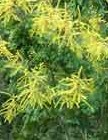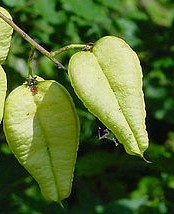 Native to China, Japan and Korea, golden-chain tree is a small deciduous tree with a rounded outline, wide-spreading branches, and a fabulous display of yellow flowers all over the tree in summer. The bright green pinnately compound leaves emerge in spring with a pinkish to bronze caste and are 6-15” long with each leaflet being 1-4” long. In fall, the color of the leaves may turn yellow with an orange caste or fade to yellowish green. The yellow flowers have a red center and are borne in clusters 12-15” long. They give way to 2” long fruits that are papery and inflated, mature to a coppery tan and persist into winter. The light gray-brown bark develops furrows and ridges as it matures. Tolerant of wind, long periods of drought, and alkaline soil, golden-rain tree has a deep root system and open branching that allows grass to grow under it. This is an good choice for lawns, patios, specimens, and urban sites. Golden-rain tree is a member of the soapberry family, Sapindaceae, that also includes maple, horsechectnut, and lychee. The genus name, Koelreuteria, Joseph Gottlienb, Koelreuter (1733-1806), a prefessor of natural history at Karlsruhe, and a pioneer investigator in plant hybridization. The specific epithet, paniculata, comes from the Latin word panicula meaing tuft, the diminutive of panus meaning thread, and refers to the floral inflorescence.
Native to China, Japan and Korea, golden-chain tree is a small deciduous tree with a rounded outline, wide-spreading branches, and a fabulous display of yellow flowers all over the tree in summer. The bright green pinnately compound leaves emerge in spring with a pinkish to bronze caste and are 6-15” long with each leaflet being 1-4” long. In fall, the color of the leaves may turn yellow with an orange caste or fade to yellowish green. The yellow flowers have a red center and are borne in clusters 12-15” long. They give way to 2” long fruits that are papery and inflated, mature to a coppery tan and persist into winter. The light gray-brown bark develops furrows and ridges as it matures. Tolerant of wind, long periods of drought, and alkaline soil, golden-rain tree has a deep root system and open branching that allows grass to grow under it. This is an good choice for lawns, patios, specimens, and urban sites. Golden-rain tree is a member of the soapberry family, Sapindaceae, that also includes maple, horsechectnut, and lychee. The genus name, Koelreuteria, Joseph Gottlienb, Koelreuter (1733-1806), a prefessor of natural history at Karlsruhe, and a pioneer investigator in plant hybridization. The specific epithet, paniculata, comes from the Latin word panicula meaing tuft, the diminutive of panus meaning thread, and refers to the floral inflorescence.

Type: Small deciduous tree
Outstanding Feature: Flowers
Form: Rounded, developing a flat top
Growth Rate: Moderate
Bloom: Terminal panicles 12-15” long of bright yellow flowers ½” wide are produced in summer followed by inflated, papery fruits 2” long.
Size: 25-40’ H x 3—40’ W
Light: Full sun
Soil: Fertile, medium moist, well-drained; drought tolerant when mature
Hardiness: Zones 5-9
Care: Stake and prune young plants to encourage high brancing; Periodically, prune out weak, diseased, or broken branches.
Pests and Diseases: Susceptible to coral spot fungus, root rot, and canker.
Propagation: Seed, root cuttings.
